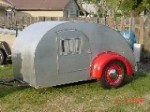Nuvite Application Guide
Using Nuvite Polish
Use sparingly for best results. Tiny dabs are all that are required, whether you are using the the
compounding polisher or the Cyclo polisher.
If too much polish is used, the polish acts as a lubricant and prevents the cutting/polishing action
from being effective. The cutting/polishing action is most effective in those last moments when the
polish is disappearing.
Be careful when polishing near painted surfaces, decals or plastic trim. The coarser grades of Nuvite
will remove or damage paint. The S grade seems to be safe to apply over good paint.
Check the Application Guide section of the web site for detailed procedures for polishing with the
compounding polisher and Cyclo polisher.
Description of the Different Grades of Nuvite
Nuvite G6, Coarse grade. Nuvite describes this grade as a "smart abrasive" that provides a quick
initial cut and then breaks down into a fine cut. It is used on pitted, chipped or scratched surfaces.
Nuvite F9, Very coarse grade. This grade has large sharp particles that remain sharp and do not
break down during the polishing. It is used on severely corroded finishes or on new aluminum that
has a rough mill finish. Nuvite describes it as a "very heavy cut, for heavy corrosion." For most
applications, use the F7 rather than the F9.
Nuvite F7, Medium-coarse grade. This grade has sharp particles that stay sharp but they are much
smaller than those in the F9. It is used on corroded, chipped or scratched surfaces. Nuvite describes
it as a "heavy cut, for heavy corrosion."
Nuvite C, Medium-fine grade. This grade has softer, more rounded particles. It is used on surfaces
that are in relatively good condition with only moderate corrosion.
Nuvite S, Finish polish. This is used after the surfaces have been brought into good condition with
the other grades of Nuvite. It brings out the mirror finish with great depth of image.
Which Grade of Nuvite to Use
There is no one right answer. Every piece of aluminum is different. Different degrees of corrosion or
damage. Different alloys. Different mill finishes. Some have Alclad coating and some do not.
Because everyone's technique is a little different, some experimentation is required. But here are
some general guidelines.
The term "compounding' below refers to a using a rotary-type polisher called a compounding buffer
or polisher in the auto detailing trade. It puts the most horsepower into the polishing action and is
used to quickly remove corrosion and smooth out chips and scratches. However it produces swirl
marks that must be removed with the Cyclo polisher.
The term "Cyclo" below refers to using the Cyclo polisher, which is a two-head, random orbit
polisher. This type of polisher is used to remove the swirl marks left by the compounding polisher
and do the finish polishing. However it is not very effective on corroded or damages surfaces.
2/6/2005
file://F:\My Webs\Under Construction\perfectpolish13.8\AppGuide1.htm







